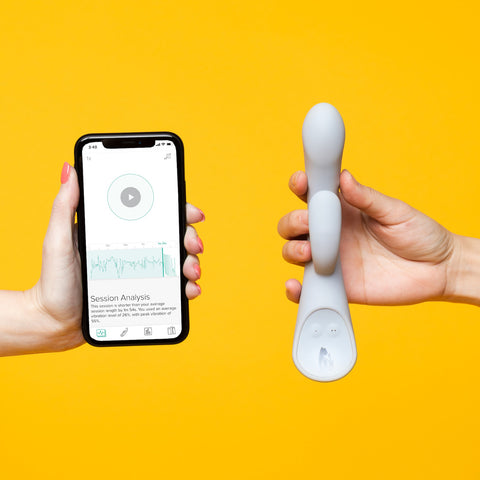
By Lindsey Curtis
Vaginal discharge is a natural part of life, but it can raise a lot of questions. What exactlyisvaginal discharge and what purpose does it serve? Is it the same as cervical mucus and arousal fluid? And is squirting really just pee? Let’s dive right in and explore the various types of vaginal fluids and their role in our reproductive health and sex lives.
What is vaginal discharge?
Vaginal discharge is a normal part of life for many people with vaginas. Produced by glands inside your vagina and cervix, fluids flow out of the vagina throughout the day and can vary throughout the month, such as during the menstrual cycle. This natural process is your body’s way of keeping your vagina healthy. “Discharge contains some bacteria and cells, and is part of the vagina’s self-cleaning function,” explains sociologist & clinical sexologist Sarah Melancon.
There is often some degree of vaginal discharge every day, but the amount, consistency and smell can vary from day to day, depending on where you are in your menstrual cycle, age, and use of oral contraceptives. Normal vaginal discharge is typically clear or milky in color and may have a subtle scent.
What is cervical mucus?
Ever notice a stretchy, clear fluid in your underwear in the days leading up to ovulation? That’s cervical mucus. You may feel wetter — and hornier — than your baseline in the days leading up to ovulation, thanks to a surge of the hormone estrogen, which is responsible for many of the physical changes you experience throughout your menstrual cycle. Cervical mucus is a clear, egg-white-like fluid that is meant to help sperm survive its journey to the egg.
After ovulation, the hormone progesterone surges while the amount of cervical mucus decreases, and turns into a thicker, stickier substance. This stops sperm (and any other foreign substances) from getting through the cervix.

What is arousal fluid?
Anyone who’s engaged in goodforeplay knows that getting wet feels much different from your run-of-the-mill vaginal discharge and cervical mucus. Arousal fluid — the lubrication your body produces when you’re turned on — is meant to reduce friction during sexual activity and make penetration more comfortable.
During the first stage of sexual arousal, your Bartholin’s glands — pea-sized glands located on either side of your vaginal opening — secrete a fluid to prepare your body for sexual activity. But the glands aren’t solely responsible for making you wet. During foreplay, increased blood flow to the vulva and clitoris cause your labia to “sweat”, and fluid to pass through your vagina to get you ready for sex.
What is “squirting”?
A sensation that feels so intensely good (that may or may not accompany an orgasm!) that it has you squirting might feel like a holy experience. And in some cultures, it is. “In some cultures, this fluid is considered sacred and is called ‘Amrita’, which means sacred nectar,” says Melancon.
Studies have shown that anywhere from 10-54 percent of women who experience female ejaculation, sometimes referred to as “squirting”. The amount of fluid released when a woman ejaculatesaverages about 2 ounces.
But what is it? Until recently, most people assumed the fluid was just pee. Although some urine may be in the milky white fluid,female ejaculate contains some of the same components as semen. “The fluid contains some components that resemble semen such as prostate-specific antigen (PSA), prostatic acid, and phosphatase, as well as creatinine and urea,” says Dr. Michael Ingber, Urology and Gynecology specialist. “Female ejaculation comes from “thefemale prostate” —Skene’s glands, located near the front wall of the vagina, and surrounding urethra.”
Bonus: squirting may help the vagina self-clean and protect against unwanted bacteria because people who squirt areless likely to deal with UTIs.

Abnormal Discharge
You’ll notice different types of vaginal fluid and discharge throughout your menstrual cycle — this is completely normal and changes cyclically along with your hormones. But sudden or abnormal changes can be indicative of a problem, such as a bacterial or sexually transmitted infection. Here are some things to look out for:
- Consistency: Textured, thicker fluid or unusually thin
- Color: Brownish, greenish or grayish
- Smell: Fishy, metallic or just different from your baseline
- Volume: unexpected volume, sometimes associated with other symptoms such as itching or burning sensations
If you notice any of these changes, talk with your healthcare provider.
===

Using built-in sensors and an intuitive mobile app, Lioness actually lets you visualize your arousal and orgasms.
Simply use Lioness like any other vibrator, then review the results on your phone. Soon, you'll begin to understand how your body responds - and how to make every climax stronger and more enjoyable.
Our woman-led engineering team has dedicated YEARS to improving your pleasure, and we can't wait for you to experience Lioness for yourself.
Click hereto learn more about the Lioness.



